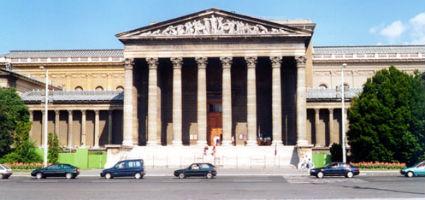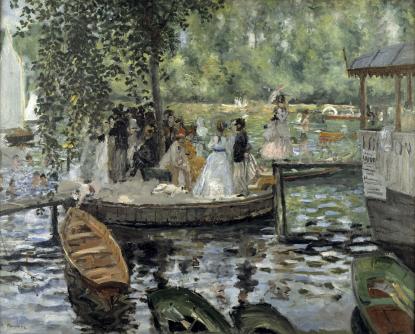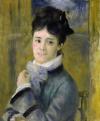2026. January 2. Friday
Budapest Museum of Fine Arts - Budapest
 |
Address: 1146, Budapest Dózsa György út 41.
Phone number: (1) 469-7100
E-mail: info@szepmuveszeti.hu
Opening hours: Tue-Sun 10:00-18:00
|
The exhibition has closed for visitors.
2023.09.22. - 2024.01.21.
Museum tickets, service costs:
|
Ticket for adults
(valid for the permanent exhibitions)
|
2800 HUF
|
/ capita
|
|
Ticket for adults
|
3200 HUF
|
|
|
Group ticket for adults
|
2900 HUF
|
|
|
Ticket for students
(valid for the permanent exhibitions)
|
1400 HUF
|
/ capita
|
|
Ticket for students
|
1600 HUF
|
|
|
Group ticket for students
|
1400 HUF
|
|
|
Ticket for pensioners
(valid for the permanent exhibitions)
|
1400 HUF
|
/ capita
|
|
Audio guide
|
800 HUF
|
|
|
Video
|
1000 HUF
|
The Museum of Fine Arts, Budapest presents the first comprehensive and representative exhibition of the works of Pierre-Auguste Renoir in Hungary. The large-scale exhibition, focusing on the French master’s depiction of figures, displaysalmost seventy compositions by Renoir. The Museum of Fine Artsorganised the exhibition in cooperationwith the Musée d’Orsay and the Musée de l’Orangerie in Paris, and loaned works from over twenty public collections.

Renoir (1841–1919) isconsidered one of the most famous impressionist painters, yet much of his rich and varied oeuvre, spanning six decades from the early 1860s until his death in 1919, cannot be restricted to the confines of the movement. As a young artist, he was one of the founders of the new style, whose adherents sought to capture momentary impressions, changing light and colour effects, and to promote spontaneity in painting. However, after his pivotal trip to Italy in 1881, he turned away from impressionism and its aspirations.Seeking a more solid and more permanent form of expression, he turned to his great predecessors for guidance:first to Raphael,then to the masters of French rococo – Jean-Antoine Watteau, Jean-Honoré Fragonard, and François Boucher–, and finally to Titian and Peter Paul Rubens. Engaged in intensive dialogue with his role models for decades, Renoir created a new, modern tradition. Throughout the first decades of the twentieth century and right up to the end of his life, Renoir was able to remain an experimental and innovative artist who inspired the great figures of the next generation, Pablo Picasso and Henri Matisse, with his unparalleled painterly approach, breathtaking productivity and exemplary perseverance.
“I am a painter of figures,” declared Pierre-Auguste Renoir, implying that the humanfigure was always at the centre of his art. As a portraitist, he sensitively captured the nuances of faces, the radiance of his models’ gazes, and the splendour of clothes. In his genre pictures, he recorded the ordinary, convivial interactions between people and the new phenomena of modern life. In his nudes, he celebrated the beauty of the female body and the silky glow of skin. His paintings are peopled byfriends, fellow painters, art lovers, and family members, who thus become part of a lively, carefree, harmonious world. Through paintings, works on paper, and sculptures, the exhibition focuses onRenoir’s relationship with the models that inspired his art.
In addition to drawings, prints, and sculptures, visitors to the exhibition can view some forty paintings, including masterpieces such as The Swing, Dance in the Country,and Claude Renoir as a Clown. Thealmost thirty works by Renoirpreserved in the Museum of Fine Arts, Budapest also play a prominent role. The first Hungarian exhibition dedicated to the painter presents his artistic development in a chronological and thematic arrangement.
The exhibition, organised in cooperation with the Musée d’Orsay and the Musée de l’Orangerie in Paris, displaystwenty-sixworks loanedfrom these two museums, as well as works of outstanding importance from almost twenty other prominent European public collections, including the Petit Palais and the Musée National Picasso in Paris, the Museo Nacional Thyssen-Bornemisza in Madrid, and the Belvedere in Vienna.
The displayedportraitsdemonstrate how Renoir’s painterly approach changed depending on the status and role of his models (family, friends, and clients). The exhibition also explores the painter’s interest in the leisure activities fashionable in Paris and its suburbs at the time (Scenes of Modern Life). This section provides us with the opportunity to examinehow Renoir modernised the eighteenth-century tradition of the fête galante (gallant feast). The different versions of Young Girls at the Piano allow visitors to observe how Renoir depicted his models in interiors; the theme of home and intimacy can also be explored in his family portraits. The next section of the exhibition focuses on Renoir’s nudes. In the works painted between 1869 and 1919, the audiencecan follow Renoir’s efforts to place his models in landscapes, as well as how he moved from an impressionistic representation of the play of light and shadow on his figures to a more unified painterly approach.
A separate section is devoted to the French master’s last masterpiece,The Bathers, executed in 1919. At the end of the exhibition, some display cases evoke Renoir’s works formerly heldin Hungarian private collections, while also drawing attention to works that were displayed to the Hungarian public in the early twentieth century. Finally, the figure of the elderly Renoir comes to life in a short film.
Through the selected works, we can examine the relationship between the painter and his models. Renoir not only observed but also reinvented the features and facial expressions of his models, depicting them in everyday situations, thus striving to create not only an artistic ideal but also an ideal of life, in which individual happiness and social harmony come together.

Renoir (1841–1919) isconsidered one of the most famous impressionist painters, yet much of his rich and varied oeuvre, spanning six decades from the early 1860s until his death in 1919, cannot be restricted to the confines of the movement. As a young artist, he was one of the founders of the new style, whose adherents sought to capture momentary impressions, changing light and colour effects, and to promote spontaneity in painting. However, after his pivotal trip to Italy in 1881, he turned away from impressionism and its aspirations.Seeking a more solid and more permanent form of expression, he turned to his great predecessors for guidance:first to Raphael,then to the masters of French rococo – Jean-Antoine Watteau, Jean-Honoré Fragonard, and François Boucher–, and finally to Titian and Peter Paul Rubens. Engaged in intensive dialogue with his role models for decades, Renoir created a new, modern tradition. Throughout the first decades of the twentieth century and right up to the end of his life, Renoir was able to remain an experimental and innovative artist who inspired the great figures of the next generation, Pablo Picasso and Henri Matisse, with his unparalleled painterly approach, breathtaking productivity and exemplary perseverance.
“I am a painter of figures,” declared Pierre-Auguste Renoir, implying that the humanfigure was always at the centre of his art. As a portraitist, he sensitively captured the nuances of faces, the radiance of his models’ gazes, and the splendour of clothes. In his genre pictures, he recorded the ordinary, convivial interactions between people and the new phenomena of modern life. In his nudes, he celebrated the beauty of the female body and the silky glow of skin. His paintings are peopled byfriends, fellow painters, art lovers, and family members, who thus become part of a lively, carefree, harmonious world. Through paintings, works on paper, and sculptures, the exhibition focuses onRenoir’s relationship with the models that inspired his art.
In addition to drawings, prints, and sculptures, visitors to the exhibition can view some forty paintings, including masterpieces such as The Swing, Dance in the Country,and Claude Renoir as a Clown. Thealmost thirty works by Renoirpreserved in the Museum of Fine Arts, Budapest also play a prominent role. The first Hungarian exhibition dedicated to the painter presents his artistic development in a chronological and thematic arrangement.
The exhibition, organised in cooperation with the Musée d’Orsay and the Musée de l’Orangerie in Paris, displaystwenty-sixworks loanedfrom these two museums, as well as works of outstanding importance from almost twenty other prominent European public collections, including the Petit Palais and the Musée National Picasso in Paris, the Museo Nacional Thyssen-Bornemisza in Madrid, and the Belvedere in Vienna.
The displayedportraitsdemonstrate how Renoir’s painterly approach changed depending on the status and role of his models (family, friends, and clients). The exhibition also explores the painter’s interest in the leisure activities fashionable in Paris and its suburbs at the time (Scenes of Modern Life). This section provides us with the opportunity to examinehow Renoir modernised the eighteenth-century tradition of the fête galante (gallant feast). The different versions of Young Girls at the Piano allow visitors to observe how Renoir depicted his models in interiors; the theme of home and intimacy can also be explored in his family portraits. The next section of the exhibition focuses on Renoir’s nudes. In the works painted between 1869 and 1919, the audiencecan follow Renoir’s efforts to place his models in landscapes, as well as how he moved from an impressionistic representation of the play of light and shadow on his figures to a more unified painterly approach.
A separate section is devoted to the French master’s last masterpiece,The Bathers, executed in 1919. At the end of the exhibition, some display cases evoke Renoir’s works formerly heldin Hungarian private collections, while also drawing attention to works that were displayed to the Hungarian public in the early twentieth century. Finally, the figure of the elderly Renoir comes to life in a short film.
Through the selected works, we can examine the relationship between the painter and his models. Renoir not only observed but also reinvented the features and facial expressions of his models, depicting them in everyday situations, thus striving to create not only an artistic ideal but also an ideal of life, in which individual happiness and social harmony come together.



